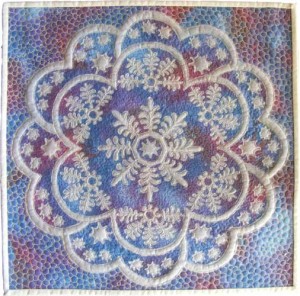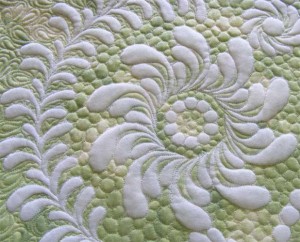 You probably know her already, and probably even visit her blog. Because Geta is well-known for her amazing shadow trapunto quilts. Here she shares some insights with us about how she got started quilting, and the challenges she faces in a country with no quilting tradition.
You probably know her already, and probably even visit her blog. Because Geta is well-known for her amazing shadow trapunto quilts. Here she shares some insights with us about how she got started quilting, and the challenges she faces in a country with no quilting tradition.
1.Very quickly, tell us where you are from and how long you have been quilting.
I am from Romania, an Eastern European country. I have been quilting for ten years.
 2. Is quilting part of the tradition of your country? If so, tell us a little about the customs. If not, how is it you became interested and took on quilting?
2. Is quilting part of the tradition of your country? If so, tell us a little about the customs. If not, how is it you became interested and took on quilting?
Quilting is an unknown craft for most people in my country. I discovered it absolutely by chance on Internet. I saw pictures and I was in love! Before quilting I used to make clothes for myself. I love colors and I wanted to wear my favorite ones. When I understood that quilting is about colors and fabrics I wanted to make quilts myself. And soon it became the passion (addiction) of my life.
3. What fabrics do you use? Is it difficult to purchase the cotton fabrics most often used for quilting in your country? Do you buy locally? Are there fabrics you use that would be considered unusual throughout the quilting world?
Usually I can’t find here the fabric I want to use in my quilts and I order them from abroad. I can buy some Romanian cotton fabric but its quality is not the one required by a quilt that will be frequently used and washed. My first quilt was made out of polyester fabric. Every patch was becoming smaller after every touch of the iron so it was a nightmare matching them. I have pieced and quilted even slippery polyester fabric (satin), crepe fabric and home decorator fabric (heavy cotton, velveteen). If I find a beautiful fabric, I quilt it, it doesn’t matter that it is not 100% cotton.
You can see a few of my first quilts here.
4. What do you use for batting? Once again, are you able to find this locally or do you have to order it online?
If I ask in a shop here for cotton batting, usually the answer is: “but batting is made out of polyester!” So cotton batting (or other natural fibers) is a luxury product for Romanian quilters. We have to buy it from abroad and shipping is very expensive. Sometimes I have paid more for shipping than I paid for the batting itself. But I am very happy with the polyester batting I can find here. It’s fluffy and thick and works wonderfully for most of my projects. It is more difficult to quilt than flat (cotton) batting, but still I use it because it is cheap. Less money to spend, but more work!
5. What about other supplies? Threads, stabilizers, fusible web, etc? What are you able to purchase locally and what do you have to obtain from outside your country?
Usually I can find some of these supplies here but if I need something special, again I have to order it from abroad.
 6. Do you use “modern” quilting tools, like a mat, rotary cutter and specialty rulers? Have you had to improvise and adapt tools?
6. Do you use “modern” quilting tools, like a mat, rotary cutter and specialty rulers? Have you had to improvise and adapt tools?
I am always interested in tools that make my quilting faster and better. I made just a few quilts using pencils, templates and scissors. My first online order from abroad was for a cutting mat, ruler and rotary cutter. Now, except for rulers, these things can be bought here. But they all are imported and expensive.
7. You do some incredible shadow trapunto, and I know you have had to be creative when it comes to your sewing machine(s). Tell us a little about what you use and how you have had to adapt to meet your needs.
I bought my first sewing machine capable to do free motion quilting soon after I started learning quilting. At the moment I did not know what kind of machine should I use so I read on Internet about the machines used for quilting. Soon I bought a Pfaff sewing machine. No one in the shop where I bought it could show me how to use it for quilting. I had to learn from the manual. A few years later this machine needed some repairs. The mechanic I brought to fix it was amazed by the way I use this machine for free motion quilting and he recommended me an industrial machine. I bought such a machine and he made some adjustments on it and now I use that machine only for free motion quilting. An industrial machine has a lot of advantages.
You can see my machine here.
 8. What about other quilters? Is there a group or association that meets in your city/country? Do you plan events together?
8. What about other quilters? Is there a group or association that meets in your city/country? Do you plan events together?
There are a group on Internet and a small association, but personally I don’t know more than 25 Romanian quilters.
I am sure there are more quilters here, but probably some of them don’t have Internet access and at this moment the Internet is the easiest way to communicate each other.
And I suppose that there are people here that combine small pieces of fabric to make useful things for home or themselves but they did not even know they are making quilts and definitely they not know that abroad quilting is an industry.
I don’t meet often my quilting friends. We are lucky if we meet once in a year. To see one of them I had to drive 9 hours. To see another one I need 5-6 hours (still we met just once in three years). I don’t see more than once in a year even a friend who lives close to me. So, I can say I have online quilting friends but I continue to be and work as a lonely quilter!
9. What would you say are the biggest challenges or difficulties for a quilter in your country?
Not having quilting friends who could give you a small advice. When I started quilting it was me, a quilting book and pictures on Internet (no quilting blogs, no tutorials and no quilting videos).The book seemed to be written in Chinese. I was looking at the pictures with a magnifying glass, just to be sure I understood it correctly! During the first two years I have made quilts but I was not sure whether they were real quilts or not. I hadn’t seen a real quilt before.
Another challenge would be the language. As the resources in Romanian language are very limited, the only chance for someone who doesn’t speak a foreign language is to find a teacher.
For Romanians, quilting is a very expensive hobby. We have to buy most of the quilting needs from abroad or, if we buy them here, they are very expensive as most of them are imported. So, not every person who would like to try quilting and use tools that are really helpful could actually do it.
But I know that someone truly passionate about quilting will succeed…even if she will start working with scissors, cardboard templates, marking pens and strips of fabrics ripped from bed sheets. And she will probably read a quilting book with the help of a dictionary.
But if she wants more (like beautiful fabrics that last or natural batting), if she wants her quilts to be used for years, if she wants to quilt faster and better- she has to make sacrifices for all of these.
10. And what are the greatest opportunities?
It comes from the long years of communism- we are used to working hard, we are used to learning by ourselves, we are used to improvising. These things, the Internet and the quilting community I found there helped me tremendously to grow as quilter.
 11. In one short sentence, what is your quilting philosophy?
11. In one short sentence, what is your quilting philosophy?
“Follow your passion and success will follow you.” And the measure of success is given by the happiness, joy and fulfillment that quilting brings me. I am a blessed girl who works and plays at the same time.
12. Is there anything else you would like to share that you feel is central to who you are as an “international” quilter?
I hope that my quilts speak well the “quilting language” and will tell you more about me than my English words! Please come to see them on my blog!
*************************************************
Visit Geta!
 I am a self-learner. I taught myself to sew and to quilt. And I taught myself how to draw. I am learning how to dye my own fabrics and am dabbling with mixed media. I am a quilt designer and teacher, and design and publish my own line of quilt patterns. With this blog I would like to share the bits and pieces of my life.
I am a self-learner. I taught myself to sew and to quilt. And I taught myself how to draw. I am learning how to dye my own fabrics and am dabbling with mixed media. I am a quilt designer and teacher, and design and publish my own line of quilt patterns. With this blog I would like to share the bits and pieces of my life.
3 Comments
Geta is so very talented, as you are too! Great post Angie.
SewCalGal
http://www.sewcalgal.blogspot.com
Estoy gratamente sorprendida! Nunca hubiera imaginado que se pudieran hacer labores tan bellas en Trapunto, una de las técnicas de Quilting que más me ha gustado. Gracias, Angie por tu iniciativa de conectarnos unas a otras y compartir conocimientos. Estoy tan entusiasmada, que quizá me anime a iniciar un blog para compartir mis pocas y noveles experiencias, pero que para más de alguien serán novedosas.
Geta IS A GREAT FRIEND AND A TRUE PROFESSIONAL